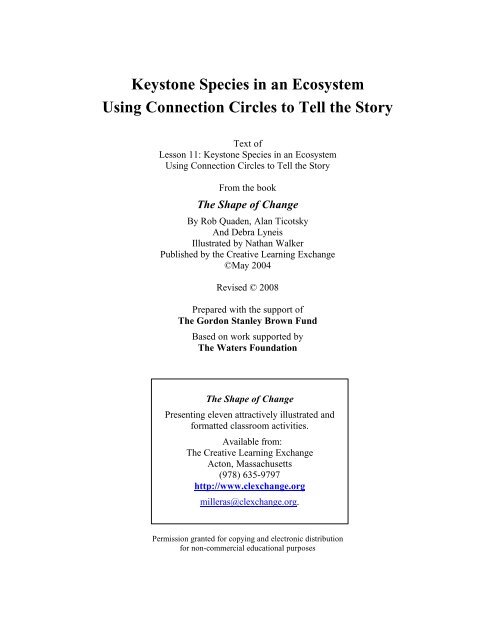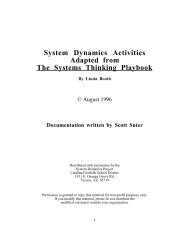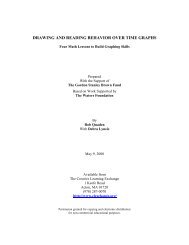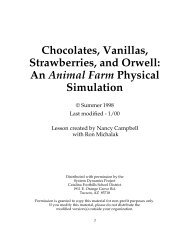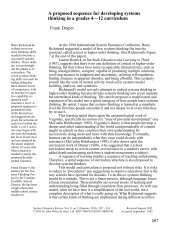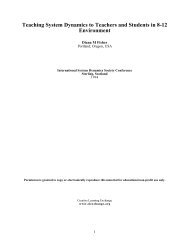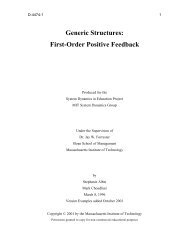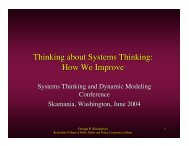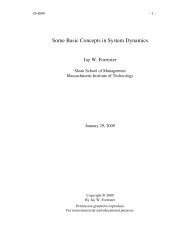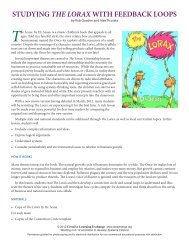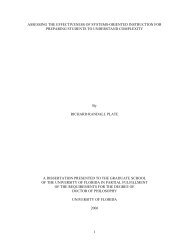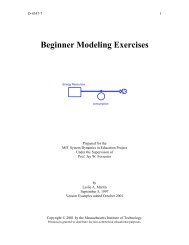Keystone Species in an Ecosystem Using Connection Circles to Tell ...
Keystone Species in an Ecosystem Using Connection Circles to Tell ...
Keystone Species in an Ecosystem Using Connection Circles to Tell ...
You also want an ePaper? Increase the reach of your titles
YUMPU automatically turns print PDFs into web optimized ePapers that Google loves.
<strong>Keys<strong>to</strong>ne</strong> <strong>Species</strong> <strong>in</strong> <strong>an</strong> <strong>Ecosystem</strong>Us<strong>in</strong>g <strong>Connection</strong> <strong>Circles</strong> <strong>to</strong> <strong>Tell</strong> the S<strong>to</strong>ryText ofLesson 11: <strong>Keys<strong>to</strong>ne</strong> <strong>Species</strong> <strong>in</strong> <strong>an</strong> <strong>Ecosystem</strong>Us<strong>in</strong>g <strong>Connection</strong> <strong>Circles</strong> <strong>to</strong> <strong>Tell</strong> the S<strong>to</strong>ryFrom the bookThe Shape of Ch<strong>an</strong>geBy Rob Quaden, Al<strong>an</strong> TicotskyAnd Debra LyneisIllustrated by Nath<strong>an</strong> WalkerPublished by the Creative Learn<strong>in</strong>g Exch<strong>an</strong>ge©May 2004Revised © 2008Prepared with the support ofThe Gordon St<strong>an</strong>ley Brown FundBased on work supported byThe Waters FoundationThe Shape of Ch<strong>an</strong>gePresent<strong>in</strong>g eleven attractively illustrated <strong>an</strong>dformatted classroom activities.Available from:The Creative Learn<strong>in</strong>g Exch<strong>an</strong>geAc<strong>to</strong>n, Massachusetts(978) 635-9797http://www.clexch<strong>an</strong>ge.orgmilleras@clexch<strong>an</strong>ge.org.Permission gr<strong>an</strong>ted for copy<strong>in</strong>g <strong>an</strong>d electronic distributionfor non-commercial educational purposes
Introduction<strong>Ecosystem</strong>s are built upon complex <strong>in</strong>terrelationships among org<strong>an</strong>isms <strong>an</strong>d their habitats. Often,a ch<strong>an</strong>ge <strong>in</strong> the population of one species causes unexpected ch<strong>an</strong>ges <strong>in</strong> other species.Underst<strong>an</strong>d<strong>in</strong>g <strong>an</strong>d represent<strong>in</strong>g a web of ch<strong>an</strong>ges is challeng<strong>in</strong>g for the scientists who study them,let alone for readers who try <strong>to</strong> comprehend these complex situations. In this lesson, studentsread a chapter from a skillfully written science book <strong>an</strong>d use connection circles <strong>to</strong> unravel amystery of nature. 1As <strong>in</strong> previous lessons, students will frame their <strong>in</strong>quiry with these questions: What is ch<strong>an</strong>g<strong>in</strong>g?How is it ch<strong>an</strong>g<strong>in</strong>g? Why is it ch<strong>an</strong>g<strong>in</strong>g?Materialso Overhead projec<strong>to</strong>r or display boardo Several different colored markers for each studen<strong>to</strong> <strong>Connection</strong> Circle template for each student (page 15)o Posted copy of “<strong>Connection</strong> Circle Rules” (page 16)o Copies of “The Case of the Tw<strong>in</strong> Isl<strong>an</strong>ds” from The Shape of Ch<strong>an</strong>ge (2008), page 137.How It WorksIn her <strong>in</strong>formative <strong>an</strong>d enterta<strong>in</strong><strong>in</strong>g book, The Case of the Mummified Pigs <strong>an</strong>d OtherMysteries <strong>in</strong> Nature, 2 Sus<strong>an</strong> E. Qu<strong>in</strong>l<strong>an</strong> has written fourteen true s<strong>to</strong>ries that describe theresearch of ecologists who puzzle out how <strong>an</strong>d why ecosystems behave as they do. Readersdiscover the <strong>in</strong>terest<strong>in</strong>g <strong>an</strong>d often surpris<strong>in</strong>g connections among org<strong>an</strong>isms through the work ofdetectives who f<strong>in</strong>d clues <strong>to</strong> nature’s riddles.The chapter, “The Case of the Tw<strong>in</strong> Isl<strong>an</strong>ds,” exam<strong>in</strong>es why the ecosystems <strong>in</strong> the waters off twoneighbor<strong>in</strong>g Aleuti<strong>an</strong> Isl<strong>an</strong>ds are so different. As students use connection circles <strong>to</strong> trace causalrelationships <strong>in</strong> the s<strong>to</strong>ry, they discover the role of a keys<strong>to</strong>ne species, a species vital <strong>to</strong> thestability of the whole ecosystem. Students learn how feedback loops ma<strong>in</strong>ta<strong>in</strong> a delicate bal<strong>an</strong>ce<strong>in</strong> <strong>an</strong> ecosystem <strong>an</strong>d what happens when that bal<strong>an</strong>ce is disturbed.<strong>Connection</strong> <strong>Circles</strong>The purpose of a connection circle is <strong>to</strong> help students focus on the problem presentedby the author <strong>an</strong>d <strong>to</strong> uncover its causes. Here is a quick overview:o First, students briefly def<strong>in</strong>e the problem: What is the author concerned about?What is the ma<strong>in</strong> problem? What is ch<strong>an</strong>g<strong>in</strong>g over time?o Next, how is it ch<strong>an</strong>g<strong>in</strong>g? In a few words, or with a quick behavior over timegraph, students describe how the problem is <strong>in</strong>creas<strong>in</strong>g or decreas<strong>in</strong>g over time.o F<strong>in</strong>ally, students look for elements <strong>in</strong> the s<strong>to</strong>ry that contribute <strong>to</strong> the problem.They use a connection circle <strong>to</strong> org<strong>an</strong>ize their thoughts, f<strong>in</strong>d cause <strong>an</strong>d effectrelationships, <strong>an</strong>d trace the feedback loops that tie them <strong>to</strong>gether <strong>to</strong> expla<strong>in</strong> whythe problem occurs.2
Procedure1. Read “The Case of the Tw<strong>in</strong> Isl<strong>an</strong>ds,” repr<strong>in</strong>ted with permission <strong>in</strong> the Appendix of TheShape of Ch<strong>an</strong>ge (2008) beg<strong>in</strong>n<strong>in</strong>g on page 137. Students may read <strong>in</strong>dependently, shareread<strong>in</strong>g, or listen <strong>to</strong> it read aloud.2. Create connection circles summariz<strong>in</strong>g the situation described <strong>in</strong> the s<strong>to</strong>ry. If students aredraw<strong>in</strong>g connection circles for the first time, follow the procedure detailed <strong>in</strong> Lesson 10, “Do YouW<strong>an</strong>t Fries with That?” <strong>in</strong> The Shape of Ch<strong>an</strong>ge (available from www.clexch<strong>an</strong>ge.org).If students are already familiar with connection circles, give each student a <strong>Connection</strong> CircleTemplate (page 15), review the rules, <strong>an</strong>d ask pairs of students <strong>to</strong> beg<strong>in</strong> choos<strong>in</strong>g elements fortheir circles. See the Appendix (page 16) for a larger copy of the rules <strong>to</strong> post <strong>in</strong> your classroomfor easy reference.CONNECTION CIRCLE RULES1. What’s the problem: What is ch<strong>an</strong>g<strong>in</strong>g? How is it ch<strong>an</strong>g<strong>in</strong>g?2. Choose elements of the s<strong>to</strong>ry that satisfy all of these criteria:o They contribute <strong>to</strong> the problem.o They are nouns or noun phrases.o They <strong>in</strong>crease or decrease over time.3. Write your elements around the circle. Include no more th<strong>an</strong> 5 <strong>to</strong> 10.4. F<strong>in</strong>d elements that cause <strong>an</strong>other element <strong>to</strong> <strong>in</strong>crease or decrease.o Draw <strong>an</strong> arrow from the cause <strong>to</strong> the effect.o The causal connection must be direct.5. Look for feedback loops. <strong>Tell</strong> their s<strong>to</strong>ry.3. What’s the problem? What is ch<strong>an</strong>g<strong>in</strong>g? Ask students <strong>to</strong> quickly identify the problem that theauthor is present<strong>in</strong>g. They may say, “The sea otters have disappeared from the waters aroundShemya while the sea urch<strong>in</strong> population has grown there.”Ask students <strong>to</strong> def<strong>in</strong>e the problem more precisely by describ<strong>in</strong>g how the populations ch<strong>an</strong>gedover time <strong>in</strong> a graph or briefly <strong>in</strong> words. These are examples on the follow<strong>in</strong>g page. They are justquick rough sketches of the general patterns of behavior. (Students may prefer <strong>to</strong> sketch separategraphs for each population.)3
AmchitkaSeaOttersShemyaYears of Hunt<strong>in</strong>gTimeYears of RegrowthPopulationSeaOttersSeaUrch<strong>in</strong>sTimeA behavior over time graph is a l<strong>in</strong>e graph sketch that showshow someth<strong>in</strong>g ch<strong>an</strong>ged over time.What was the general pattern of the behavior?4. Rem<strong>in</strong>d students <strong>to</strong> choose elements that describe the problem <strong>an</strong>d its possible causes. Here,our ma<strong>in</strong> concern is the sea otter population that has decreased over time. The population of seaurch<strong>in</strong>s is also import<strong>an</strong>t. Other variables <strong>in</strong> the s<strong>to</strong>ry contribute <strong>to</strong> the <strong>in</strong>crease <strong>an</strong>d decrease ofthese species.4
Precise l<strong>an</strong>guage <strong>an</strong>d clear th<strong>in</strong>k<strong>in</strong>g go h<strong>an</strong>d <strong>in</strong> h<strong>an</strong>d with connection circles.o Elements must be nouns or noun phrases, qu<strong>an</strong>tities that c<strong>an</strong> <strong>in</strong>crease or decreaseover time, like the number of sea otters or the amount of s<strong>an</strong>d deposited.o Do not use words like “more” or “less” <strong>in</strong> the titles.o Remember that elements c<strong>an</strong> be t<strong>an</strong>gible, like the number of fur traders, or<strong>in</strong>t<strong>an</strong>gible, like the desire <strong>to</strong> protect the environment. Often the <strong>in</strong>t<strong>an</strong>giblevariables are keys <strong>to</strong> the problem.o <strong>Connection</strong> circles may vary. The words around each circle do not have <strong>to</strong> be thesame nor <strong>in</strong> the same order, but they should all be th<strong>in</strong>gs that work <strong>to</strong>gether <strong>to</strong>contribute <strong>to</strong> the problem.oStudents are always free <strong>to</strong> ch<strong>an</strong>ge, add or delete elements as they ref<strong>in</strong>e theirth<strong>in</strong>k<strong>in</strong>g.5. Once students have drawn their connection circles with causal arrows, share them as the focusof a class conversation.o Draw a large circle on the board or overhead projec<strong>to</strong>r.o Have each team suggest <strong>an</strong> element <strong>to</strong> put on the circle.o As a class, ref<strong>in</strong>e the list <strong>to</strong> <strong>in</strong>clude no more th<strong>an</strong> five <strong>to</strong> ten elements.o Ask each team <strong>to</strong> describe a causal arrow <strong>an</strong>d expla<strong>in</strong> their reason<strong>in</strong>g for directcausality. Encourage other teams <strong>to</strong> ask clarify<strong>in</strong>g questions. Students should refer <strong>to</strong>the text when expla<strong>in</strong><strong>in</strong>g their reason<strong>in</strong>g.Aga<strong>in</strong>, you may w<strong>an</strong>t <strong>to</strong> review the more detailed <strong>in</strong>structions <strong>in</strong> Lesson 10, “Do You W<strong>an</strong>tFries with That?”Remember, a connection circle is a th<strong>in</strong>k<strong>in</strong>g <strong>to</strong>ol,a way <strong>to</strong> surface <strong>an</strong>d exam<strong>in</strong>e mental models.It is not a mold for one “right” <strong>an</strong>swer.5
Here is one example of a connection circle for “The Case of the Tw<strong>in</strong> Isl<strong>an</strong>ds.” Expect studentexamples <strong>to</strong> vary.Ask students <strong>to</strong> expla<strong>in</strong> their arrows: How did a ch<strong>an</strong>ge <strong>in</strong> one element cause a ch<strong>an</strong>ge <strong>in</strong><strong>an</strong>other?o An <strong>in</strong>crease <strong>in</strong> the number of fur traders caused a decrease <strong>in</strong> the number of sea ottersbecause traders hunted <strong>an</strong>d killed sea otters. Also, a decrease <strong>in</strong> traders caused <strong>an</strong><strong>in</strong>crease <strong>in</strong> sea otters because they could multiply unharmed.o An <strong>in</strong>crease <strong>in</strong> the shrimp population caused <strong>an</strong> <strong>in</strong>crease <strong>in</strong> the number of fish becausefish eat shrimp. A decrease <strong>in</strong> the number of shrimp caused a decrease <strong>in</strong> the numberof fish.o An <strong>in</strong>crease <strong>in</strong> kelp pl<strong>an</strong>ts caused <strong>an</strong> <strong>in</strong>crease <strong>in</strong> s<strong>an</strong>d <strong>an</strong>d silt because kelp calmed thewaters allow<strong>in</strong>g sediment <strong>to</strong> be deposited. The <strong>in</strong>creased sediment then buried the seaurch<strong>in</strong>s caus<strong>in</strong>g them <strong>to</strong> decrease. Students might draw <strong>an</strong> arrow suggest<strong>in</strong>g that <strong>an</strong><strong>in</strong>crease <strong>in</strong> kelp caused a decrease <strong>in</strong> urch<strong>in</strong>s, but this is not a direct cause. Rem<strong>in</strong>dstudents <strong>to</strong> be very careful <strong>in</strong> their th<strong>in</strong>k<strong>in</strong>g about what caused what.Remember, these are only sample draw<strong>in</strong>gs.Let students present their own ideas <strong>an</strong>d encourage them <strong>to</strong> weigh the ideas of others.Students are always free <strong>to</strong> ch<strong>an</strong>ge their draw<strong>in</strong>gsas they cont<strong>in</strong>ue <strong>to</strong> ref<strong>in</strong>e their mental models <strong>to</strong>gether.6
6. Ask teams of students <strong>to</strong> trace a closed “loop.” C<strong>an</strong> they start at one element, follow thearrows around the circle <strong>an</strong>d return <strong>to</strong> where they started? Each of these pathways is a feedbackloop that tells part of the s<strong>to</strong>ry. Trace each loop <strong>in</strong> a different color. (It helps <strong>to</strong> start with <strong>an</strong>element that has m<strong>an</strong>y connections <strong>to</strong> <strong>an</strong>d from it.)After students trace a loop, ask them <strong>to</strong> draw a simplified draw<strong>in</strong>g that <strong>in</strong>cludes only the elementsfrom the traced loop, as shown <strong>in</strong> the follow<strong>in</strong>g examples. Aga<strong>in</strong>, student draw<strong>in</strong>gs will vary.Do not present these examples <strong>to</strong> students. Allow them <strong>to</strong> discover the feedback <strong>in</strong> the s<strong>to</strong>ry forthemselves. Let representatives from each team present feedback loops <strong>an</strong>d share their s<strong>to</strong>rieswith the class.The circle below shows one large feedback loop. Trac<strong>in</strong>g the feedback loop reveals why theproblem occurred; don’t skip these steps.Sea OttersFur TradersSea Urch<strong>in</strong>sDesire <strong>to</strong> ProtectBiodiversityKelpEagles <strong>an</strong>d SealsShrimpFishStart<strong>in</strong>g at the <strong>to</strong>p, <strong>an</strong> <strong>in</strong>crease <strong>in</strong> sea otters caused a decrease <strong>in</strong> sea urch<strong>in</strong>s because sea otterseat urch<strong>in</strong>s. Fewer urch<strong>in</strong>s allowed the kelp pl<strong>an</strong>ts <strong>to</strong> <strong>in</strong>crease. An <strong>in</strong>crease <strong>in</strong> kelp caused <strong>an</strong><strong>in</strong>crease <strong>in</strong> shrimp, which then caused <strong>an</strong> <strong>in</strong>crease <strong>in</strong> fish, which then caused <strong>an</strong> <strong>in</strong>crease <strong>in</strong> eagles<strong>an</strong>d seals. With abund<strong>an</strong>t wildlife, people were less worried about biodiversity. A decrease <strong>in</strong> thedesire <strong>to</strong> protect biodiversity allowed the number of traders <strong>to</strong> <strong>in</strong>crease, so the number of seaotters beg<strong>an</strong> <strong>to</strong> decrease.This is a bal<strong>an</strong>c<strong>in</strong>g feedback loop. We started with <strong>an</strong> <strong>in</strong>crease <strong>in</strong> sea otters, but go<strong>in</strong>g aroundthe loop, the cha<strong>in</strong> of events caused sea otters <strong>to</strong> decrease. If we traced the loop aga<strong>in</strong>, thedecrease <strong>in</strong> sea otters would then become <strong>an</strong> <strong>in</strong>crease, bal<strong>an</strong>c<strong>in</strong>g back <strong>an</strong>d forth each time aroundthe loop.7
7. Look for other feedback loops. Here are some examples:Otters <strong>an</strong>d Fur TradersHere is a possible loop l<strong>in</strong>k<strong>in</strong>g otters <strong>an</strong>d fur traders.Sea OttersFur TradersDesire <strong>to</strong> ProtectBiodiversityTrac<strong>in</strong>g the loop, <strong>an</strong> <strong>in</strong>crease <strong>in</strong> fur traders <strong>in</strong> the 19 th Century caused a decrease <strong>in</strong> seaotters <strong>to</strong> d<strong>an</strong>gerously low levels. An awareness of the decl<strong>in</strong>e caused <strong>an</strong> <strong>in</strong>crease <strong>in</strong> thedesire <strong>to</strong> protect biodiversity. This led <strong>to</strong> a decrease <strong>in</strong> hunt<strong>in</strong>g. This is also a bal<strong>an</strong>c<strong>in</strong>gloop – <strong>an</strong>y ch<strong>an</strong>ge works <strong>to</strong> res<strong>to</strong>re itself around the loop aga<strong>in</strong>.Note: Students trace the different loops on their orig<strong>in</strong>al connection circles <strong>in</strong> differentcolors before draw<strong>in</strong>g separate feedback loops. They c<strong>an</strong> draw these loops freeh<strong>an</strong>dwithout us<strong>in</strong>g connection circles as templates.The s<strong>to</strong>ry gets complicated, but don’t worry.It is easier when students construct <strong>an</strong>d talk about their own circles.This is the reason for do<strong>in</strong>g connection circles <strong>in</strong> the first place:Students c<strong>an</strong> underst<strong>an</strong>d <strong>an</strong>d communicate ideas that are difficult <strong>to</strong> expressus<strong>in</strong>g more conventional <strong>to</strong>ols.8
Sea Urch<strong>in</strong>s <strong>an</strong>d KelpHere is <strong>an</strong>other feedback loop. Sea urch<strong>in</strong>s eat kelp pl<strong>an</strong>ts. The kelp pl<strong>an</strong>ts calm thewater movement <strong>an</strong>d trap s<strong>an</strong>d <strong>an</strong>d silt on the oce<strong>an</strong> bot<strong>to</strong>m. S<strong>an</strong>d <strong>an</strong>d silt smother seaurch<strong>in</strong>s.Sea Urch<strong>in</strong>sS<strong>an</strong>d <strong>an</strong>d SiltKelpTrac<strong>in</strong>g the loop for the circumst<strong>an</strong>ces around Shemya Isl<strong>an</strong>d, <strong>an</strong> <strong>in</strong>crease <strong>in</strong> sea urch<strong>in</strong>scaused a decrease <strong>in</strong> kelp pl<strong>an</strong>ts. Fewer kelp pl<strong>an</strong>ts me<strong>an</strong>t less s<strong>an</strong>d was deposited. Adecrease <strong>in</strong> s<strong>an</strong>d provided a more suitable habitat for a further <strong>in</strong>crease <strong>in</strong> sea urch<strong>in</strong>s <strong>an</strong>d<strong>an</strong>other decrease <strong>in</strong> kelp pl<strong>an</strong>ts. In this spiral, the sea urch<strong>in</strong>s cont<strong>in</strong>ued <strong>to</strong> multiply <strong>an</strong>dthe kelp disappeared.However, around Amchitka Isl<strong>an</strong>d, the opposite occurred. An <strong>in</strong>itial decrease <strong>in</strong> seaurch<strong>in</strong>s caused <strong>an</strong> <strong>in</strong>crease <strong>in</strong> kelp pl<strong>an</strong>ts. More kelp caused more s<strong>an</strong>d. More s<strong>an</strong>dme<strong>an</strong>t even fewer sea urch<strong>in</strong>s <strong>an</strong>d more <strong>an</strong>d more kelp. This time the spiral drove the seaurch<strong>in</strong> population down <strong>an</strong>d the kelp thrived <strong>to</strong> harbor greater biodiversity.This is a good example of a re<strong>in</strong>forc<strong>in</strong>g loop – sometimes also called a virtuous or viciouscycle. Any ch<strong>an</strong>ge gets amplified over <strong>an</strong>d over aga<strong>in</strong>, spiral<strong>in</strong>g either up or down.Feedback LoopsRe<strong>in</strong>forc<strong>in</strong>g loops drive accelerat<strong>in</strong>g growth or decl<strong>in</strong>e <strong>in</strong> systems.Bal<strong>an</strong>c<strong>in</strong>g loops work <strong>to</strong> keep re<strong>in</strong>forc<strong>in</strong>g loops <strong>in</strong> check.When someth<strong>in</strong>g disrupts this delicate bal<strong>an</strong>ce <strong>in</strong> <strong>an</strong> ecosystem, are<strong>in</strong>forc<strong>in</strong>g loop c<strong>an</strong> spur a rapid growth or decl<strong>in</strong>e of a species– a clue <strong>to</strong> the mystery <strong>in</strong> our s<strong>to</strong>ry.Sea Otters <strong>an</strong>d Sea Urch<strong>in</strong>s: Preda<strong>to</strong>rs <strong>an</strong>d Prey9
Because sea otters prey upon sea urch<strong>in</strong>s, <strong>an</strong> <strong>in</strong>crease <strong>in</strong> sea otters causes a decrease <strong>in</strong>sea urch<strong>in</strong>s. A decrease <strong>in</strong> urch<strong>in</strong>s then causes a decrease <strong>in</strong> otters as their food supplydw<strong>in</strong>dles. Trac<strong>in</strong>g around the loop aga<strong>in</strong>, a decrease <strong>in</strong> otters allows the urch<strong>in</strong>s <strong>to</strong>reestablish themselves. This is <strong>an</strong>other bal<strong>an</strong>c<strong>in</strong>g loop – <strong>an</strong>y ch<strong>an</strong>ge res<strong>to</strong>res itself,bal<strong>an</strong>c<strong>in</strong>g back <strong>an</strong>d forth each time around the loop.Sea OttersSea Urch<strong>in</strong>sThis feedback loop is typical of preda<strong>to</strong>r/prey feedback loops <strong>in</strong> nature. The populationsbal<strong>an</strong>ce each other. Too m<strong>an</strong>y preda<strong>to</strong>rs will reduce the prey population <strong>to</strong> levels that willcause the preda<strong>to</strong>rs <strong>to</strong> run short of food. When the prey population exp<strong>an</strong>ds <strong>to</strong>o much,more preda<strong>to</strong>rs will hunt them <strong>an</strong>d br<strong>in</strong>g down their numbers.8. While shar<strong>in</strong>g feedback loops with the whole class, look for elements that appear <strong>in</strong> more th<strong>an</strong>10
one loop. Most s<strong>to</strong>ries conta<strong>in</strong> overlapp<strong>in</strong>g loops. This diagram connects all the previous loops.Sea OttersFur TradersSea Urch<strong>in</strong>sS<strong>an</strong>d <strong>an</strong>d SiltDesire <strong>to</strong> ProtectBiodiversityKelpEagles <strong>an</strong>d SealsShrimpFishTrac<strong>in</strong>g the <strong>in</strong>tertw<strong>in</strong>ed loops, notice how kelp pl<strong>an</strong>ts provide food for shrimp, trigger<strong>in</strong>g abiodiversity <strong>in</strong>crease, while also caus<strong>in</strong>g s<strong>an</strong>d <strong>an</strong>d silt <strong>to</strong> build up. The s<strong>an</strong>d <strong>an</strong>d silt loop drivesthe sea urch<strong>in</strong> population down, further enabl<strong>in</strong>g the kelp <strong>to</strong> grow. In this diagram, sea urch<strong>in</strong>s<strong>an</strong>d sea otters both have two arrows lead<strong>in</strong>g from them, signify<strong>in</strong>g multiple outcomes caused bych<strong>an</strong>ges <strong>in</strong> their populations.Trac<strong>in</strong>g the s<strong>to</strong>ry of each loop expla<strong>in</strong>s why the problem ch<strong>an</strong>ged over time.9. Ask students <strong>to</strong> revisit their orig<strong>in</strong>al behavior over time graphs def<strong>in</strong><strong>in</strong>g the problem, or haveeach team choose <strong>an</strong> element from the circle <strong>an</strong>d sketch how it ch<strong>an</strong>ged from the time whenhunters arrived <strong>in</strong> the late 1800s <strong>to</strong> the time when “The Case of the Two Isl<strong>an</strong>ds” was written.Emphasize that the general shape of the graph is import<strong>an</strong>t – it c<strong>an</strong>not be precise because we haveno specific data. Share the graphs <strong>an</strong>d ask students <strong>to</strong> expla<strong>in</strong> how they relate <strong>to</strong> the feedbackloops they have uncovered.An ecosystem is a delicate bal<strong>an</strong>ce of m<strong>an</strong>y feedback loops.As students uncover these <strong>in</strong>terdependencies,they beg<strong>in</strong> <strong>to</strong> appreciate the complexity of natural systems.BRINGING THE LESSON HOME11
Give students a ch<strong>an</strong>ce <strong>to</strong> br<strong>in</strong>g the lesson full circle. What did they learn? Pos<strong>in</strong>g stimulat<strong>in</strong>gquestions like these will help students ask better questions themselves.? M<strong>an</strong>y th<strong>in</strong>gs were happen<strong>in</strong>g at once <strong>in</strong> this s<strong>to</strong>ry. How did the connection circle helpyou sort them out?The mystery of the tw<strong>in</strong> isl<strong>an</strong>ds often seems baffl<strong>in</strong>g at first. Encourage students <strong>to</strong> reflec<strong>to</strong>n their th<strong>in</strong>k<strong>in</strong>g <strong>an</strong>d on the process of underst<strong>an</strong>d<strong>in</strong>g complexity by look<strong>in</strong>g for the<strong>in</strong>terwoven causal loops underly<strong>in</strong>g the problem.In us<strong>in</strong>g connection circles, the th<strong>in</strong>k<strong>in</strong>g process is import<strong>an</strong>t – not just the product.? Did you solve the mystery of the tw<strong>in</strong> isl<strong>an</strong>ds? What effect did sea otters have on the seaurch<strong>in</strong> population <strong>an</strong>d the bal<strong>an</strong>ce of the two ecosystems?Around Amchitka Isl<strong>an</strong>d, the sea otter population <strong>in</strong>creased. This caused a decrease <strong>in</strong>the number of sea urch<strong>in</strong>s. That allowed the kelp forests <strong>to</strong> grow thickly because theywere not be<strong>in</strong>g destroyed by sea urch<strong>in</strong>s. The kelp provided habitat for shrimp, which fedm<strong>an</strong>y fish. The fish became food for seals <strong>an</strong>d eagles. The <strong>in</strong>creased kelp also shelteredthe deposits of s<strong>an</strong>d <strong>an</strong>d silt on the oce<strong>an</strong> floor, which smothered the bot<strong>to</strong>m dwellerswho might try <strong>to</strong> live there.In contrast, sea otters had not returned <strong>to</strong> Shemya Isl<strong>an</strong>d <strong>an</strong>d a large population of seaurch<strong>in</strong>s lived <strong>in</strong> the waters there. The sea urch<strong>in</strong>s prevented the growth of kelp, so fewshrimp <strong>an</strong>d fish could survive <strong>in</strong> the <strong>in</strong>hospitable environment. Bot<strong>to</strong>m dwellers thriveds<strong>in</strong>ce the s<strong>an</strong>d <strong>an</strong>d silt did not build up over the oce<strong>an</strong> floor, but these creatures were notdesirable food for most fish species. With few fish <strong>to</strong> attract them, seals <strong>an</strong>d eagles didnot colonize Shemya Isl<strong>an</strong>d <strong>an</strong>d its surround<strong>in</strong>g waters.Feedback Loops <strong>Tell</strong> the S<strong>to</strong>ryFeedback loops expla<strong>in</strong> why the ecosystems were so different.An ecosystem is a delicate bal<strong>an</strong>ce of feedback loops. Positiveloops drive rapid population growth or decl<strong>in</strong>e, but natureprovides bal<strong>an</strong>c<strong>in</strong>g loops <strong>to</strong> keep positive loops from spiral<strong>in</strong>gout of control.When hunters disturbed the bal<strong>an</strong>ce by remov<strong>in</strong>g the sea ottersfrom the ecosystem, the sea urch<strong>in</strong> population boomed caus<strong>in</strong>gm<strong>an</strong>y other ch<strong>an</strong>ges <strong>to</strong> the ecosystem.? How did hunters affect the isl<strong>an</strong>ds’ ecosystems?12
Fur traders hunted sea otters <strong>to</strong> the br<strong>in</strong>k of ext<strong>in</strong>ction. The decl<strong>in</strong>e of the sea otterpopulation allowed sea urch<strong>in</strong>s <strong>to</strong> proliferate, <strong>an</strong>d the urch<strong>in</strong>s devastated the kelp forests.When kelp forests decrease, m<strong>an</strong>y mar<strong>in</strong>e <strong>an</strong>imal species are deprived of habitat <strong>an</strong>dtheir numbers decl<strong>in</strong>e as well. Without hunters, sea otters could thrive around AmchitkaIsl<strong>an</strong>d.? Author Sus<strong>an</strong> Qu<strong>in</strong>l<strong>an</strong> calls the sea otter a “keys<strong>to</strong>ne species.” What does she me<strong>an</strong>?When the sea otter was removed from the Aleuti<strong>an</strong> Isl<strong>an</strong>ds, the ecosystem collapsed <strong>an</strong>dbecame barren of m<strong>an</strong>y species. Similarly, if the keys<strong>to</strong>ne <strong>in</strong> <strong>an</strong> arch is removed, all theother s<strong>to</strong>nes will fall. Any species that is disproportionately import<strong>an</strong>t (i.e., compared <strong>to</strong>its population) <strong>in</strong> the ma<strong>in</strong>ten<strong>an</strong>ce <strong>an</strong>d bal<strong>an</strong>ce of <strong>an</strong> ecosystem, <strong>an</strong>d whose removaldisrupts or destroys the food web, is thought <strong>to</strong> be a keys<strong>to</strong>ne species. Some scientistsbelieve that only preda<strong>to</strong>rs c<strong>an</strong> be keys<strong>to</strong>ne species but others disagree.? What are the keys<strong>to</strong>ne species <strong>in</strong> ecosystems where we live?Among <strong>an</strong>imals generally considered <strong>to</strong> be keys<strong>to</strong>ne species are prairie dogs, beavers,freshwater bass, gray wolves, <strong>an</strong>d salmon.? Where c<strong>an</strong> we learn more about how the feedback structure of the Tw<strong>in</strong> Isl<strong>an</strong>dsecosystem caused the problem we observed?For more <strong>in</strong>formation on this lesson <strong>an</strong>d its next steps, see Lesson 11 <strong>in</strong> our next book,The Shape of Ch<strong>an</strong>ge, S<strong>to</strong>cks <strong>an</strong>d Flows, also available from the Creative Learn<strong>in</strong>gExch<strong>an</strong>ge at www.clexch<strong>an</strong>ge.org.Additional Background InformationStudents often generate m<strong>an</strong>y good questions that go beyond the orig<strong>in</strong>al s<strong>to</strong>ry. Here is somemore background <strong>in</strong>formation that might be helpful.? Why had sea otters come back <strong>to</strong> Amchitka but not Shemya?The s<strong>to</strong>ry only tells us that a few otters had escaped hunters but “they had not returnedyet <strong>to</strong> Shemya Isl<strong>an</strong>d.” Researchers have proposed several theories <strong>to</strong> expla<strong>in</strong> theabund<strong>an</strong>ce of sea otters on some isl<strong>an</strong>ds <strong>an</strong>d their scarcity on others. Among the causeshypothesized are coastal currents, algae production, complex fac<strong>to</strong>rs affect<strong>in</strong>g otter prey,predation on otter pups, <strong>an</strong>d environmental contam<strong>in</strong>ation. Interested students c<strong>an</strong>pursue this s<strong>to</strong>ry further.? In the absence of sea urch<strong>in</strong>s, do sea otters eat so much of <strong>an</strong>other species that it becomesdepleted?Sea otters c<strong>an</strong> deplete their food sources rapidly. As is the case with other species,feedback loops <strong>in</strong> the environment operate <strong>to</strong> reduce otter populations when food isscarce <strong>an</strong>d allow it <strong>to</strong> <strong>in</strong>crease when prey is abund<strong>an</strong>t.13
? What is currently happen<strong>in</strong>g <strong>to</strong> the sea otter population <strong>in</strong> the Aleuti<strong>an</strong> Isl<strong>an</strong>ds?James Estes <strong>an</strong>d other scientists have cont<strong>in</strong>ued <strong>to</strong> study the sea otter population <strong>an</strong>ddiscovered more threats s<strong>in</strong>ce 1990. It was estimated that between 150,000 <strong>to</strong> 300,000otters lived <strong>in</strong> the Pacific Coast region before the hunters arrived <strong>in</strong> the 19th Century. Atreaty <strong>in</strong> 1911 s<strong>to</strong>pped hunt<strong>in</strong>g but only about 1,000 otters were left.In the 1970s, the otter population near Alaska was estimated <strong>to</strong> have recovered <strong>to</strong> over100,000. But <strong>in</strong> the years lead<strong>in</strong>g <strong>to</strong> the beg<strong>in</strong>n<strong>in</strong>g of the 21st Century, they decl<strong>in</strong>edaga<strong>in</strong>. The culprit this time may be a different species of hunter – killer whales. Killerwhales usually prefer <strong>to</strong> eat sea lions <strong>an</strong>d seals, but those populations have decl<strong>in</strong>ed due<strong>to</strong> reduced fish s<strong>to</strong>cks. Killer whales have turned <strong>to</strong> sea otters <strong>an</strong>d have reduced theirnumbers <strong>to</strong> d<strong>an</strong>gerously low levels aga<strong>in</strong>. Kelp forests have been noted <strong>to</strong> be <strong>in</strong> seriousdecl<strong>in</strong>e by year 2000. Students will recognize familiar feedback relationships <strong>in</strong> theses<strong>to</strong>ries <strong>to</strong>o.Students have used connection circles <strong>to</strong> def<strong>in</strong>e theproblem <strong>an</strong>d f<strong>in</strong>d the causes of ch<strong>an</strong>ge over time.With practice, they will eventually learn <strong>to</strong> recognizethe feedback loops <strong>in</strong> the systems around them withoutthe need of this <strong>to</strong>ol.Name___________________14
<strong>Connection</strong> Circle Template1. What’s the problem: What is ch<strong>an</strong>g<strong>in</strong>g? How is it ch<strong>an</strong>g<strong>in</strong>g?2 Choose elements of the s<strong>to</strong>ry that satisfy all of these criteria:o They contribute <strong>to</strong> the problem.o They are nouns or noun phrases.o They <strong>in</strong>crease or decrease <strong>in</strong> the s<strong>to</strong>ry.3. Write your elements around the circle. Include no more th<strong>an</strong> 5 <strong>to</strong> 10.4. F<strong>in</strong>d elements that cause <strong>an</strong>other element <strong>to</strong> <strong>in</strong>crease or decrease.o Draw <strong>an</strong> arrow from the cause <strong>to</strong> the effect.o The causal connection must be direct.5. Look for feedback loops. <strong>Tell</strong> their s<strong>to</strong>ry.15
<strong>Connection</strong> Circle Rules1. What’s the problem:What is ch<strong>an</strong>g<strong>in</strong>g? How is it ch<strong>an</strong>g<strong>in</strong>g?2. Choose elements of the s<strong>to</strong>ry that satisfy allof these criteria:They contribute <strong>to</strong> the problem.They are nouns or noun phrases.They <strong>in</strong>crease or decrease <strong>in</strong> the s<strong>to</strong>ry.3. Write your elements around the circle.Include no more th<strong>an</strong> 5 <strong>to</strong> 10.4. F<strong>in</strong>d elements that cause <strong>an</strong>other element <strong>to</strong><strong>in</strong>crease or decrease.Draw <strong>an</strong> arrow from the cause <strong>to</strong> the effect.The causal connection must be direct.5. Look for feedback loops. <strong>Tell</strong> their s<strong>to</strong>ry.16
1 We have revised this lesson from the version <strong>in</strong> the earlier edition of The Shape of Ch<strong>an</strong>ge (2004) <strong>to</strong> make ourexpl<strong>an</strong>ation of connection circles more clear. For more <strong>in</strong>formation on this lesson <strong>an</strong>d its next steps, also seeLesson 11 <strong>in</strong> The Shape of Ch<strong>an</strong>ge, S<strong>to</strong>cks <strong>an</strong>d Flows (2007) by Quaden, Ticotsky <strong>an</strong>d Lyneis, also available fromThe Creative Learn<strong>in</strong>g Exch<strong>an</strong>ge at www.clexch<strong>an</strong>ge.org.2“The Case of the Tw<strong>in</strong> Isl<strong>an</strong>ds” is a chapter from The Case of the Mummified Pigs <strong>an</strong>d Other Mysteries ofNature, by Sus<strong>an</strong> E. Qu<strong>in</strong>l<strong>an</strong>, illustrated by Jennifer Owens Dewey, published by Carol<strong>in</strong>e House, Boyds MillsPress, Inc., 1995. For your convenience, the chapter is repr<strong>in</strong>ted with permission on page 137. We urge you <strong>to</strong> getthe book <strong>an</strong>d use connection circles <strong>to</strong> explore its m<strong>an</strong>y other <strong>in</strong>trigu<strong>in</strong>g s<strong>to</strong>ries.17


